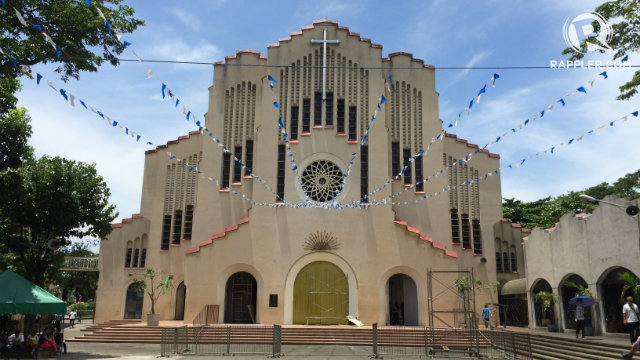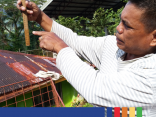(This report was first published online by Rappler on 27 June 2015. Original version is available in this link.)
MANILA, Philippines – What do you do if a magnitude 7.2 earthquake strikes Metro Manila on a weekend, when you, like most people, are out in malls or even churches?
This is the question devotees in Baclaran church had in mind when they attended the "Talakayan: Valley Fault System" forum organized by Assistance and Cooperation for Community Resilience (ACCORD) and Redemptorists of Baclaran on Friday, June 26.
(This report was first published online by Rappler on 27 June 2015. Original version is available in this link.)
MANILA, Philippines – What do you do if a magnitude 7.2 earthquake strikes Metro Manila on a weekend, when you, like most people, are out in malls or even churches?
This is the question devotees in Baclaran church had in mind when they attended the "Talakayan: Valley Fault System" forum organized by Assistance and Cooperation for Community Resilience (ACCORD) and Redemptorists of Baclaran on Friday, June 26.
More than a hundred devotees from the Redemptorists, priests, seminarians, social ministry staff, lay ministers, and youth volunteers gathered at the church to learn about basic information on earthquakes and how they can prepare for the "Big One" which, according to scientists, may happen anytime.
"The Redemptorists saw what happened in Bohol, where centuries-old churches collapsed during the 2013 earthquake. It was lucky that the earthquake hit when there were no masses, minimizing casualties. That is not the case with Baclaran church, which never closes," Marieta Lupig Alcid, executive director of ACCORD, said in a press statement.
Earthquake-related hazards
The church's location makes it prone to various types of earthquake-related hazards.
The popular Marian shrine built in 1958 is located around 6.5 kilometers away from the nearest point of the West Valley Fault. Once the fault moves, a very destructive ground-shaking Intensity VIII will be felt in the area. (READ: What dangers await when the West Valley Fault moves)
Its proximity to Manila Bay, where the Manila Trench is located, also makes it vulnerable to liquefaction and tsunamis. The trench can generate a magnitude 8.3* earthquake that can cause tsunamis as high as 3.5 meters, according to Joan Salcedo of the Philippine Institute of Volcanology and Seismology (Phivolcs).
Making it more vulnerable is the number of people who flock the church, especially on Wednesdays, also known as "Baclaran Day."
"During peak hours, there are as much as 120,000 people in the church and its immediate vicinity. Given all these, earthquake safety and preparedness is a concern for Baclaran Church," the statement said.
In the event of an earthquake, Salcedo suggested that lay ministers be assigned to specific areas of the church.
"'Iyong lay ministers natin di ba usually naka-assign sila for every group para sa communion, puwede din sigurong sila na lang din yung naka-assign (or siguro may marshalls na nakaassign), itong mga sitting on this side, may evacuation. Those sitting on the right side for example, ito yung lalabasan. So, hahatiin din yung mga tao," Salcedo explained.
(Our lay ministers, if possible, can also be assigned to different areas of the church, just like during communions [if not, marshalls can also be assigned]. Those sitting in certain areas have pre-determined evacuation sites in the vicinity of the church already. Those sitting on the right side for example, this is where they go out.)
One of the advantages of the church is its many doors, Salcedo added.
"Hindi ka lalabas sa isang pinto lang. So mahahati mo yung tao sa different sides. 'Yun nga lang, pag labas nila, dapat meron ng identified area kung saan pupunta," she said.
(You won't have to go out of a single door. You can divide the people to different sides of the church. But once they go out, they should already know where to go.)
Prepare old churches, buildings, historical sites
While it is important for people to know what to do when an earthquake strikes, the safety of buildings and structures is also important.
In previous interviews with Rappler, Phivolcs director Renato Solidum stressed the importance of building structures that can withstand earthquakes.
"[Ground] shaking does not kill, collapsing buildings do," he said. (WATCH: #Talkthursday: Metro Manila earthquake scenarios)
In October 2013, a magnitude 7.2 earthquake struck Visayas, destroying centuries-old churches and killing about 28 people.
Salcedo said historical sites should be prepared for earthquakes, as well.
"Ang ideal is they coordinate with other offices kung ano ba yung tamang design para ma-restore, para ma-withstand niya yung ganitong klase ng shaking…. Halimbawa, may mga existing na tayo [na buildings], may mga technologies especially sa engineering na nakatayo na, may pwedeng magawa pa na patibayin natin." Salcedo explained.
(The ideal thing to do is they coordinate with other offices regarding the right design when it comes to restoring [or retrofitting], so that old structures can withstand a certain type of shaking…For example, for existing buildings, we have technologies that can help make them stronger.)
Photo credits: Gwen dela Cruz





